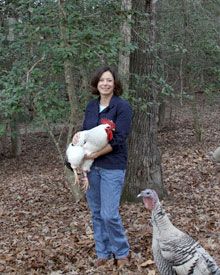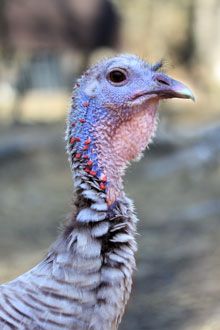Heritage turkeys: Veterinary epidemiologist raises the turkeys America forgot
Dr. Julie Gauthier raises seven heritage varieties of turkey, geese, ducks and chicken, educating students and backyard flock-keepers, to conserve breeds that nearly disappeared.

Veterinary epidemiologist Julie Gauthier raises heritage poultry, including Magpie and Saxony ducks, Delaware chickens, and Narragansett and Beltsville turkeys at Chickcharney Farm in Wake Forest, North Carolina. Gauthier, an import risk analyst at the U.S. Department of Agriculture, also co-wrote Chicken Health for Dummies.The best time of day at Chickcharney Farm in Wake Forest, North Carolina, is afternoon. Work is done and the remaining light of the day is golden. Julie Gauthier, DVM, MPH, DACVPM, steps out onto her 10 acres with a cup of coffee. "I love the fall-leaves are on the ground and the turkeys are looking glorious," she says. Less than a week from Thanksgiving, Gauthier says this time of year at Chickcharney Farm is pretty spectacular. "I just like being out there and watching them."
A veterinary epidemiologist with the U.S. Department of Agriculture (USDA), Gauthier raises two varieties of heritage turkeys on her farm: the Narragansett and the Beltsville. This is in addition to two heritage varieties of geese, two varieties of ducks and one variety of heritage chicken. Her flock started years ago with just six chickens in the backyard. Now on a mission to conserve heritage poultry, her flock has grown considerably.
"Poultry can be an obsession for a lot of people, including me," she says. "Chickens are a gateway drug. Ducks, geese and turkeys are really interesting as well."
In fact, she finds turkeys fascinating. "The turkeys are charming," she says. "They're really personable creatures. They're curious.
"When I go outside, the chickens could care less, but the turkeys are always right there trying to figure out what you're doing. They're much more willing to interact with people. [Their curiosity] is their method of dealing with strange things in their environment."
Gauthier's scientific perspective and approach to genetic conservation sets her apart from others who may simply appreciate heritage birds. "A lot of people are interested in how pretty the birds are, but you have to have an eye for how they're built," she says. She values the genetic traits associated with good egg laying and strong legs that help a bird get around easily.
And if something bad occurs, such as a disease outbreak, her veterinary background serves her well. She's learned to quickly assess why it happened. "The only good medicine when you're a flock keeper is prevention," she says. "My training as a veterinarian and in public health helps me to see that. Not just what antibiotic should I use, but how did this happen in the first place?"
Chicken Health for Dummies
Gauthier admits that when she was in veterinary school, poultry medicine was limited to a weekend workshop. "There wasn't a lot of opportunity when I was in school," she says. Gauthier graduated from Michigan State University School of Veterinary Medicine in 1993 and went on to earn her master's degree in public health from Yale University.
"There's a huge gap out there" when it comes to poultry medicine, she says. "There are poultry consultants who work with commercial poultry who really know their stuff. Then there are these backyard folks and they have no one to go to. They take them to small animal veterinarians-we don't know anything!"
Gauthier says there's a real and growing need for veterinary expertise as more people begin keeping backyard flocks. "There a lot of do-it-yourself stuff going on out there," she says. "It's dangerous for the chickens and for the people." She should know. She wrote the book on it.
Gauthier co-wrote Chicken Health for Dummies with Rob Ludlow, which came out in January 2013. "There's a lot of mistakes being made now-that doesn't have to happen," she said. "They didn't happen in the past because people had knowledge."
For example, some uneducated flock-keepers are allowing chickens to free-range around old houses, where they pick up lead paint. People don't realize what they're exposing themselves and their animals to. "They're checking the Internet and talking to each other and using over-the-counter treatments," Gauthier says.

A Narragansett hen struts around Gauthier's Chickcharney Farm.She says Chicken Health for Dummies was her chance to get some quality information out there. With Gauthier's interest in poultry, doing the writing and research for the book was fun. "It's amazing to look into that world … or maybe just people who are obsessed with poultry think that's interesting," she says with a laugh, acknowledging that she's in the minority-even among veterinarians-when it comes to her intense interest in poultry.
While the lack of veterinarians going into food animal medicine is old news, the issue becomes more urgent considering the burgeoning interest in hobby farming. "There's a big need and I'm not sure how it's going to be filled," Gauthier says. Realistically-financially-she gets it. "There's not enough veterinarians willing to serve that niche and there's good reason for that," she says. "People can't afford to spend money on modern diagnostics for farm animals.
"It's tough to be that old-model community veterinarian who's doing everything, but there's still that need and I think it's growing," she continues. "I don't know what the answer is. It's a public health concern as well as animal welfare."
In the meantime, she does her little bit on her 10 acres. "I do a lot of teaching out of here," she says. She hosts workshops for local flock owners; she hosts a veterans' workshop. "I often have veterinary students want to come out and do flock procedures," she says.
But this week she won't be teaching. She'll take the week off from workshops and "cubicle life" as an import risk analyst at the U.S. Department of Agriculture (USDA) and focus on Thanksgiving.
Mission Thanksgiving
The Narragansett and Beltsville turkeys happily foraging on Gauthier's farm are the future of their breeds. The Narragansett was found on Thanksgiving tables in New England 150 years ago. The Beltsville small white was developed by the USDA Agricultural Research Service in the 1930s in response to consumer requests for a smaller, "clean-dressing" table bird. Popular through the 1940s and 1950s, they became nearly extinct as consumers gravitated toward larger turkeys for Thanksgiving and the industry began producing turkey products year-round.
This Thanksgiving, as they have for a generation now, nearly all Americans will feast on the commercially produced broad-breasted white turkey. This concerns Gauthier. "There is one variety that is commercially raised around the world and three companies that control the breeding stock," she says.
Gauthier explains it this way: "Think if there was only one breed of dog. That would concern people." She says livestock is going the same direction as plant-based agriculture-the number of varieties used is decreasing, along with genetic diversity and the number of companies producing the products. "We need to maintain our choices and hang on to the vast genetic diversity that our ancestors had," Gauthier says.
So she does things the old-fashioned way. Her operation won't feed the masses. She sells only 15 to 25 birds each year. "It's a very old-fashioned way to do it," she says. "The way you would have done it 150 years ago." She processes the turkeys at home, which she says results in less stress for the animal. Not only is this an issue of humane treatment, she says, but also of food quality. "I do it by hand," she says. "I try to produce something that really looks great and tastes great."
The ill-fated birds were chosen earlier in the fall. Gauthier identifies the most ideal genetic specimens to keep the flock going, and the rest? "The ones that don't make the cut are processed for meat," she says. "It's a necessary market for them. You need to show people that these birds are fabulous to eat."
She says her business plan is modest-the birds need to support themselves. She sells and ships hatching eggs and chicks all over the country to further their breeds. "I hate to say this, but the meat is a by-product of the operation," Gauthier says. "My mission is to hang on to these birds, so I need to keep a large population to keep them genetically healthy."
Gauthier takes the entire week of Thanksgiving off to process and distribute turkeys meant for the table. "Thanksgiving is a big deal here, and the turkey is the centerpiece," she says. She and her husband usually host Thanksgiving dinner, treating their guests to a Narragansett. "I process the bird, and my husband does the cooking," she says.
Once the sun starts to go down, she'll go out to tend her flock. She'll make sure the 50-gallon water barrels are full and everyone has feed. She'll monitor the birds as she checks electric fences-essential barriers as nighttime predators emerge from evening's shadows-and usher all into secure coops. "Everybody is pretty good about putting themselves to bed," Gauthier says. "All I have to do is shut the doors."
FDA approves oral drug for broad canine protection against parasites
October 7th 2024Elanco's lotilaner, moxidectin, praziquantel, and pyrantel chewable tablets (Credelio Quattro) provide a single monthly dose for protection against fleas, ticks, heartworms, roundworms, hookworms, and 3 species of tapeworm.
Read More
dvm360 announces winners of the Veterinary Heroes program
Published: September 6th 2024 | Updated: November 5th 2024This year’s event is supported by corporate sponsor Schwarzman Animal Medical Center and category sponsors Blue Buffalo Natural, MedVet, Banfield Pet Hospital, Thrive Pet Healthcare and PRN Pharmacal.
Read More